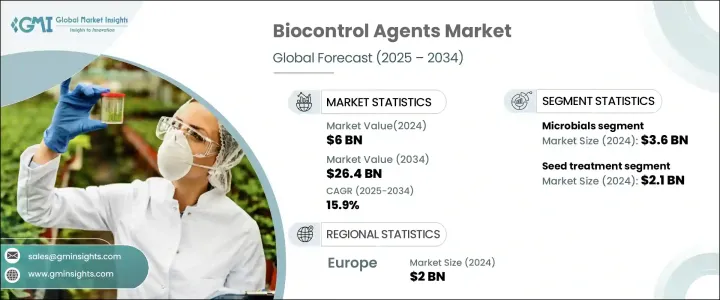
세계의 생물 방제제 시장은 2024년에 60억 달러로 평가되었고, 2025년부터 2034년에 걸쳐 15.9%의 연평균 성장률(CAGR)로 성장할 것으로 예측되고 있습니다.
생물 방제제는 농업 및 기타 분야에서 해충과 질병을 방제하는 박테리아, 곰팡이, 바이러스와 같은 자연 유기체입니다. 합성 살충제와 달리 생태학적 상호 작용에 의존하여 해로운 종을 관리하므로 보다 지속 가능한 솔루션을 제공합니다. 이러한 성장은 전 세계적으로 유기농 생산 방식에 대한 수요 증가에 힘입은 바가 큽니다. 소비자들은 식품 생산 방식에 대해 점점 더 관심을 가지면서 환경 친화적이고 건강과 생태계에 덜 해로운 방법을 선호하고 있습니다.

생물 다양성 손실, 생태계 파괴, 건강 위험 등 화학 살충제의 유해한 영향에 대한 인식이 높아지면서 생물 방제제에 대한 수요도 증가하고 있습니다. 지속 가능한 농업 관행으로의 이러한 변화는 매우 효과적이고 친환경적이며 통합 해충 관리(IPM) 시스템 내에서 잘 작동하는 생물학적 방제 방법을 채택하도록 농부들에게 동기를 부여하고 있습니다. 생물 방제제는 해충을 선택적으로 표적으로 삼을 수 있기 때문에 환경에 미치는 영향을 최소화하면서 오래 지속되는 솔루션을 제공합니다.
| 시장 범위 | |
|---|---|
| 시작 연도 | 2024년 |
| 예측 연도 | 2025-2034년 |
| 시작 금액 | 60억 달러 |
| 예측 금액 | 264억 달러 |
| CAGR | 15.9% |
시시장은 활성 물질, 작물 유형 및 적용 방법에 따라 세분화됩니다. 박테리아, 곰팡이, 바이러스와 같은 유익한 미생물을 포함하는 미생물 부문은 2024년 36억 달러로 가장 큰 비중을 차지했습니다. 이 부문은 농부들이 환경적으로 안전한 해충 관리 대안을 모색함에 따라 계속 성장하고 있습니다. 생물 방제제는 과일과 채소, 곡류, 콩류 등 다양한 작물 유형에 걸쳐 널리 사용되고 있습니다. 과일과 채소 부문은 2024년에 26억 달러의 가치를 차지했으며, 무농약 농산물에 대한 소비자 수요에 힘입어 크게 성장할 것으로 예상됩니다. 또한 2024년 21억 달러에 달하는 종자 처리 부문은 예측 기간 동안 16.7%의 연평균 성장률을 보일 것으로 예상됩니다. 이는 작물을 심기 전에 해충 문제를 예방하여 건강한 식물 성장을 보장합니다.
유럽은 2024년 20억 달러의 가치로 전 세계 생물 방제제 시장을 주도하고 있습니다. 특히 프랑스, 독일, 네덜란드 등 유럽 국가들은 지속 가능한 농업에 대한 노력으로 인해 생물 방제 제품을 빠르게 도입하고 있습니다. 살충제 사용을 줄이고 유기농법을 확대하는 것을 목표로 하는 유럽 그린 딜은 생물학적 방제 채택을 크게 촉진하고 있습니다. 이러한 변화는 통합 해충 관리와 생물학적 대안을 장려하는 EU 정책과 국가 프로그램에 의해 뒷받침되고 있습니다. 잔류 농약이 없는 식품에 대한 소비자 선호도가 높아지는 것도 이 지역 시장을 이끄는 주요 요인입니다.
The Global Biocontrol Agents Market was valued at USD 6 billion in 2024 and is projected to expand at a CAGR of 15.9% from 2025 to 2034. Biocontrol agents are natural organisms, such as bacteria, fungi, and viruses, that control pests and diseases in agriculture and other sectors. Unlike synthetic pesticides, these agents rely on ecological interactions to manage harmful species, offering a more sustainable solution. This growth is largely driven by the rising demand for organic production methods worldwide. Consumers are increasingly concerned about how food is produced, favoring methods that are environmentally friendly and less harmful to both health and ecosystems.

The demand for biocontrol agents is also being fueled by the growing awareness of the harmful effects of chemical pesticides, including their contribution to biodiversity loss, ecosystem damage, and health risks. This shift towards sustainable agricultural practices is motivating farmers to adopt biocontrol methods, as they are highly effective, eco-friendly, and work well within integrated pest management (IPM) systems. With their ability to target pests selectively, biocontrol agents offer long-lasting solutions with minimal environmental impact.
| Market Scope | |
|---|---|
| Start Year | 2024 |
| Forecast Year | 2025-2034 |
| Start Value | $6 Billion |
| Forecast Value | $26.4 Billion |
| CAGR | 15.9% |
The market is segmented by active substance, crop type, and method of application. The microbials segment, which includes beneficial microorganisms like bacteria, fungi, and viruses, held the largest share of USD 3.6 billion in 2024. This segment continues to grow as farmers seek environmentally safe pest management alternatives. Biocontrol agents are widely used across different crop types, including fruits and vegetables, cereals and grains, and pulses. The fruits and vegetables segment accounted for USD 2.6 billion in 2024 and is expected to grow significantly, driven by consumer demand for pesticide-free produce. Additionally, the seed treatment segment, valued at USD 2.1 billion in 2024, is predicted to grow at a CAGR of 16.7% during the forecast period. This application helps prevent pest problems before crops are planted, ensuring healthy plant growth.
Europe leads the global biocontrol agents market, with a valuation of USD 2 billion in 2024. European countries, particularly France, Germany, and the Netherlands, are adopting biocontrol products rapidly due to their commitment to sustainable farming. The European Green Deal, which aims to reduce pesticide use and increase organic farming, is significantly boosting biocontrol adoption. This shift is supported by EU policies and national programs promoting integrated pest management and biological alternatives. The growing consumer preference for food without pesticide residues is also a key factor driving the market in this region.